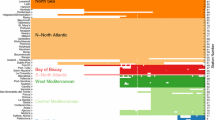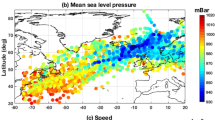Abstract
Knowledge of the likely future wind, wave and surge climate in Liverpool Bay is of importance for coastal flood defence management. We examine a 140-year time series (1960–2100) of wind and wave model projections at the WaveNet buoy location in Liverpool Bay and also of surge model projection at two ports in Liverpool Bay, namely Liverpool and Heysham. To this end we use model projections from the UK Climate Projections 09 (UKCP09) programme. We use a medium emissions scenario ensemble from the HadCM3 climate model sensitivity tests. A continental shelf model (CS3) with ~12 km resolution was used to separately simulate the waves and the surge. The models are forced by hourly wind and pressure data from the Met Office (Hadley Centre) regional climate model (RCM). Swell wave boundary conditions are generated over the full Atlantic using global climate model (GCM) winds. Analysis of significant changes in the statistics over time shows that there is little change in extreme wave and surge conditions in Liverpool Bay. Although there is a slight increase in the severity of the most extreme events, the frequency of extreme wind and wave events is slightly reduced, while the frequency of extreme surge events slightly increases over the 140-year period. From the model projections, we find that the trends in the local wind are directly reflected in the wave field within Liverpool Bay. The trends in the skew surge projections deviate slightly from those in the wind patterns.











Similar content being viewed by others
References
Allan R, Tett S, Alexander L (2009) Fluctuations in autumn-winter severe storms over the British Isles: 1920 to present. Int J Climatol 29(3):357–371
Brown JM, Souza AJ, Wolf J (2010a) An 11-year validation of wave-surge modelling in the Irish Sea, using a nested POLCOMS-WAM modelling system. Ocean Model 33(1–2):118–128
Brown JM, Souza AJ, Wolf J (2010b) An investigation of recent decadal-scale storm events in the eastern Irish Sea. J Geophys Res (Oceans) 115(C05018):12. doi:10.1029/2009JC005662
Brown JM, Bolaños R, Wolf J (2011) Impact assessment of advanced coupling features in a tide-surge-wave model, POLCOMS-WAM, in a shallow water application. J Mar Syst 87(1):13–24
Brown S, Boorman P, McDonald R, Murphy J (2009a) Use and interpretation of surface wind projections from the 11-member Met Office Regional Climate Model ensemble. UKCP09 Technical Note. p 24
Brown S, Boorman P, McDonald R, Murphy J (2009b) Supplement to: interpretation for use of surface wind speed projections from the 11-member Met Office Regional Climate Model ensemble. UKCP09 Supplement., p 7
Caires S, Sterl A (2005) A new nonparametric method to correct model data: application to significant wave height from the ERA-40 Re-analysis. J Atmos Ocean Tech 22(4):443–459
Caires S, Sterl A, Bidlot J-R, Graham N, Swail V (2004) Intercomparison of different wind wave reanalyses. J Clim 17(10):1893–1913
De Vries H, Breton M, De Mulder T, Krestenitis Y, Ozer J, Proctor R, Ruddick K, Salomon JC, Voorrips A (1995) A comparison of 2D storm surge models applied to three shallow European seas. Environ Software 10(1):23–42
Esteves LS, Williams JJ, Nock A, Lymbery G (2009) Quantifying shoreline changes along the Sefton coast (UK) and the implications for research-informed coastal management. In: Journal of Coastal Research, Proceedings of the 10th International Coastal Symposium. Lisbon, Portugal, SI 56:602–606
Flather RA (2000) Existing operational oceanography. Coast Eng 41(1–3):13–40
Greeves CZ, Pope VD, Stratton RA, Martin GM (2007) Representation of northern hemisphere winter storm tracks in climate models. Clim Dynam 28(7–8):683–702
Gulev SK, Hasse L (1999) Changes of wind waves in the North Atlantic over the last 30 years. Int J Climatol 19:1091–1117
Gulev SK, Grigorieva V (2004) Last century changes in ocean wind wave height from global visual wave data. Geophys Res Lett 31:L24302. doi:10.1029/2004GL021040
Horsburgh KJ, Wilson C (2007) Tide-surge interaction and its role in the distribution of surge residuals in the North Sea. J Geophys Res 112(C08003). doi:10.1029/2006JC004033
IPCC (2007) Coastal systems and low-lying areas. In: Parry ML, Canziani OF, Palutikof JP, van der Linden PJ, Hanson CE (eds) Chapter 6 in: Climate Change 2007: Impacts, Adaptation and Vulnerability. Contribution of Working Group II to the Fourth Assessment Report of the Intergovernmental Panel on Climate Change, 2007. . Cambridge University Press, Cambridge, United Kingdom and New York, NY, USA, p 315
Jones JE, Davies AM (1998) Storm surge computations for the Irish Sea using a three-dimensional numerical model including wave-current interaction. Continent Shelf Res 18(2):201–251
Kaminarides S (2009) UK coastal monitoring and forecasting. Met office operational report to the environment agency for the period 1st June 2008 to 31st May 2009. Met Office, United Kingdom
Komen GJ, Cavaleri L, Donelan M, Hasselmann K, Hasselmann S, Janssen PAEM (1994) Dynamics and modelling of ocean waves. Cambridge University Press, Cambridge, p 532
Leake J, Wolf J, Lowe J, Hall J, Nicholls R (2009) Response of marine climate to future climate change: application to coastal regions. In: Proceedings of the 31st International Conference on Coastal Engineering. Hamburg, August 31—September 5, 2008, 5, p 11
Lennon GW (1963) The identification of weather conditions associated with the generation of major storm surges along the west coast of the British Isles. Q J Roy Meteorol Soc 89:381–394
Lowe JA, Gregory JM (2005) The effects of climate change on storm surges around the United Kingdom. Phil Trans R Soc A 363:1313–1328
Lowe JA, Gregory JM, Flather RA (2001) Changes in the occurrence of the storm surges around the United Kingdom under future climate scenarios using a dynamic storm surge model driven by the Hadley Centre climate models. Clim Dynam 18(3–4):179–188
Lowe JA, Howard T, Pardaens A, Tinker J, Holt J, Wakelin S, Milne G, Leake J, Wolf J, Horsburgh K, Reeder T, Jenkins G, Ridley J, Dye S, Bradley S (2009) UK climate projections science report: marine and coastal projections. Met Office Hadley Centre, Exeter
Monbaliu J, Padilla-Hernández R, Hargreaves JC, Carretero-Albiach JC, Luo W, Sclavo M, Günther H (2000) The spectral wave model WAM adapted for applications with high spatial resolution. Coast Eng 41(1–3):41–62
Murphy J, Sexton D, Jenkins G, Boorman P, Booth B, Brown K, Clark R, Collins M, Harris G, Kendon L (2009) UK climate projections science report: climate change projections. Met Office Hadley Centre, Exeter
Murphy JM, Booth BBB, Collins M, Harris GR, Sexton DMH, Webb MJ (2007) A methodology for probabilistic predictions of regional climate change from perturbed physics ensembles. Phil Trans R Soc A 365(1857):1993–2028
Pye K, Blott SJ (2008) Decadal-scale variation in dune erosion and accretion rates: an investigation of the significance of changing storm tide frequency and magnitude on Sefton coast, UK. Geomorphology 102(3–4):652–666
Reichler T, Kim J (2008) How well do coupled models simulate today’s climate? Bull Am Meteorol Soc 89(3):303–311
Romeiser R (1993) Global validation of the wave model WAM over a one-year period using GEOSAT wave height data. J Geophys Res 98(C3):4713–4726
Swail VR, Cox AT (2000) On the use of NCEP–NCAR reanalysis surface marine wind fields for a long-term North Atlantic wave Hindcast. J Atmos Ocean Tech 17(4):532–545
Wang S, McGrath R, Hanafin J, Lynch P, Semmler T, Nolan P (2008) The impact of climate change on storm surges over Irish waters. Ocean Model 25(1–2):83–94
Weisse R, von Storch H, Feser F (2005) Northeast Atlantic and North Sea storminess as simulated by a regional climate model during 1958–2001 and comparison with observation. J Clim 18(3):465–479
Wolf J (1981) Surge-tide interaction in the North Sea and River Thames. In: Peregrine DH (ed) Floods due to high winds and tides. Academic, London, pp 75–94
Wolf J (2008) Coupled wave and surge modeling and implications for coastal flooding. Adv Geosci 17:1–4
Wolf J (2009) Coastal flooding: impacts of coupled wave-surge-tide models. Nat Hazards 49(2):241–260
Wolf J, Woolf DK (2006) Waves and climate change in the north-east Atlantic. Geophys Res Lett 33:L06604. doi:1029/2005GL025113
Woodworth PL, Blackman DL (2002) Changes in extreme high waters at Liverpool since 1768. Int J Climatol 22(6):697–714
Woodworth PL, Flather RA, Williams JA, Wakelin SL, Jevrejeva S (2007) The dependence of the UK extreme sea levels and storm surges on the North Atlantic Oscillation. Continent Shelf Res 27(7):935–946
Woolf D, Wolf J (2010) Storms and waves in MCCIP annual report card 2010–11. MCCIP Science Review, p 15
Yin JH (2005) A consistent poleward shift of the storm tracks in simulations of the 21st century climate. Geophys Res Lett 32(L18701):4. doi:10.1029/2005GL023684
Acknowledgments
The CoFEE project is funded under the NERC Flood Risk in Extreme Environments (FREE) program (grant NE/E002471/1) and the MICORE project is funded by the EU FP7 program (grant 202798). Both of these projects are researching the future extreme conditions in Liverpool Bay. The wave projections were funded by the Tyndall Centre Coasts programme and the surge projections were provided by Tom Howard (Met Office) as part of the UKCP09. Thanks to the UK Climate Impacts Program (UKCP09) in particular Jason Lowe (Met Office/Hadley centre) for allowing us to use the model projections. The help of Mary Hunt in analyzing some of the data as part of a Nuffield project was also appreciated.
Author information
Authors and Affiliations
Corresponding author
Rights and permissions
About this article
Cite this article
Brown, J.M., Wolf, J. & Souza, A.J. Past to future extreme events in Liverpool Bay: model projections from 1960–2100. Climatic Change 111, 365–391 (2012). https://doi.org/10.1007/s10584-011-0145-2
Received:
Accepted:
Published:
Issue Date:
DOI: https://doi.org/10.1007/s10584-011-0145-2




